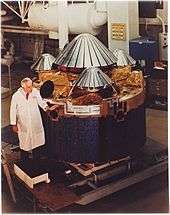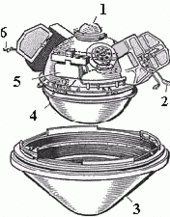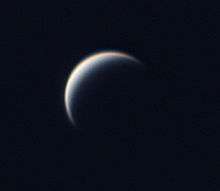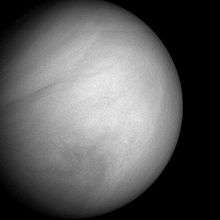Pioneer Venus Multiprobe
 Pioneer Venus Multiprobe | |
| Mission type | Venus atmospheric probes |
|---|---|
| Operator | NASA / ARC |
| COSPAR ID | 1978-078A |
| SATCAT № | 11001 |
| Website | National Space Science Data Center (NASA) |
| Mission duration | 4 months, 1 day |
| Spacecraft properties | |
| Bus | HS-507 |
| Manufacturer | Hughes |
| Launch mass | 904 kilograms (1,993 lb) |
| Dry mass |
290 kilograms (640 lb) (bus) 315 kilograms (694 lb) (large probe) 3 x 90 kilograms (200 lb) (small probes) |
| Power | 241 watts |
| Start of mission | |
| Launch date | August 8, 1978, 07:33 UTC |
| Rocket | Atlas SLV-3D Centaur-D1AR |
| Launch site | Cape Canaveral LC-36A |
| End of mission | |
| Last contact |
December 9, 1978, 20:22:55 UTC (bus) December 9, 1978, 20:55:34 UTC (day probe) |
| Orbital parameters | |
| Reference system | Heliocentric |
| Venus atmospheric probe | |
| Spacecraft component | Large Probe |
| Atmospheric entry | December 9, 1978, 18:45:32 UTC |
| Impact date | 19:39:53 UTC |
| Impact site | 4°24′N 304°00′E / 4.4°N 304.0°E |
| Venus atmospheric probe | |
| Spacecraft component | North Probe |
| Atmospheric entry | December 9, 1978, 18:49:40 UTC |
| Impact date | 19:42:40 UTC |
| Impact site | 59°18′N 4°48′E / 59.3°N 4.8°E |
| Venus atmospheric probe | |
| Spacecraft component | Day Probe |
| Atmospheric entry | December 9, 1978, 18:52:18 UTC |
| Impact date | 19:47:59 UTC |
| Impact site | 31°18′S 317°00′E / 31.3°S 317.0°E |
| Venus atmospheric probe | |
| Spacecraft component | Night Probe |
| Atmospheric entry | December 9, 1978, 18:56:13 UTC |
| Impact date | 19:52:05 UTC |
| Impact site | 28°42′S 56°42′E / 28.7°S 56.7°E |
| Venus atmospheric probe | |
| Atmospheric entry | December 9, 1978, 20:21:52 UTC |
The Pioneer Venus Multiprobe, also known as Pioneer Venus 2 or Pioneer 13 was a spacecraft launched in 1978 to explore Venus as part of NASA's Pioneer program.
Spacecraft

The Pioneer Venus Multiprobe bus was constructed by the Hughes Aircraft Company, built around the HS-507 bus. It was cylindrical in shape, with a diameter of 2.5 metres (8 ft 2 in) and a mass of 290 kilograms (640 lb). Unlike the probes, which did not begin making direct measurements until they had decelerated lower in the atmosphere, the bus returned data on Venus' upper atmosphere.
The bus was targeted to enter the Venusian atmosphere at a shallow entry angle and transmit data until destruction by the heat of atmospheric friction. The objective was to study the structure and composition of the atmosphere down to the surface, the nature and composition of the clouds, the radiation field and energy exchange in the lower atmosphere, and local information on the atmospheric circulation pattern. With no heat shield or parachute, the bus made upper atmospheric measurements with two instruments, an Ion Mass Spectrometer (BIMS) and a Neutral Mass Spectrometer (BNMS), down to an altitude of about 110 km before disintegrating on December 9, 1978.
Probes
The spacecraft carried one large and three small atmospheric probes, designed to collect data as they descended into the atmosphere of Venus. The probes did not carry photographic instruments, and were not designed to survive landing - the smaller probes were not equipped with parachutes, and the larger probe's parachute was expected to detach as it neared the ground. All four probes continued transmitting data until impact; however, one survived and continued to transmit data from the surface.
Large probe

The Large probe carried seven experiments, contained within a sealed spherical pressure vessel. The science experiments were:
- a neutral mass spectrometer to measure the atmospheric composition
- a gas chromatograph to measure the atmospheric composition
- a solar flux radiometer to measure solar flux penetration in the atmosphere
- an infrared radiometer to measure distribution of infrared radiation
- a cloud particle size spectrometer to measure particle size and shape
- a nephelometer to search for cloud particles
- temperature, pressure, and acceleration sensors
This pressure vessel was encased in a nose cone and aft protective cover. After deceleration from initial atmospheric entry at about 11.5 kilometres per second (7.1 mi/s) near the equator on the night side of Venus, a parachute was deployed at 67 km altitude. The large probe was about 150 centimetres (59 in) in diameter and the pressure vessel itself was 73.2 centimeters (28.8 in) in diameter.
Small probes


Three identical small probes, around 0.8 metres (2 ft 7 in) in diameter, were deployed. These probes consisted of spherical pressure vessels surrounded by an aeroshell, but unlike the large probe, they had no parachutes and the aeroshells did not separate from the probes.
The science experiments were:[1]
- a neutral mass spectrometer to measure the atmospheric composition
- a gas chromatograph to measure the atmospheric composition
- a solar flux radiometer to measure solar flux penetration in the atmosphere
- an infrared radiometer to measure distribution of infrared radiation
- a cloud particle size spectrometer to measure particle size and shape
- a nephelometer to search for cloud particles
- temperature, pressure, and acceleration sensors
The radio signals from all four probes were also used to characterize the winds, turbulence, and propagation in the atmosphere. The small probes were each targeted at different parts of the planet and were named accordingly.[2]
- The North probe entered the atmosphere at about 60 degrees north latitude on the day side.
- The Night probe entered on the night side.
- The Day probe entered well into the day side, and was the only one of the four probes which continued to send radio signals back after impact, for over an hour.
Launch
The Pioneer Venus Multiprobe was launched by an Atlas SLV-3D Centaur-D1AR rocket, which flew from Launch Complex 36A at the Cape Canaveral Air Force Station. The launch occurred at 07:33 on August 8, 1978, and deployed the Multiprobe into heliocentric orbit for its coast to Venus.
Arrival at Venus
Prior to the Multiprobe reaching Venus, the four probes were deployed from the main bus. The large probe was released on November 16, 1978, and the three small probes on November 20.
All four probes and the bus reached Venus on December 9, 1978. The large probe was the first to enter the atmosphere, at 18:45:32 UTC, followed over the next 11 minutes by the other three probes. The bus entered the atmosphere at 20:21:52 UTC, and returned its last signal at 20:22:55 from an altitude of 110 kilometres (68 mi).
The four probes transmitted data until they impacted the surface of Venus. The Day Probe survived impact, returning data from the surface for over an hour.
| Large Probe | North Probe | Day Probe | Night Probe | Bus | |
|---|---|---|---|---|---|
| Entry time (200 km) | 18:45:32 | 18:49:40 | 18:52:18 | 18:56:13 | 20:21:52 |
| Impact time | 19:39:53 | 19:42:40 | 19:47:59 | 19:52:05 | (signal lost at 110 km altitude) |
| Loss of signal | 19:39:53 | 19:42:40 | 20:55:34 | 19:52:07 | 20:22:55 |
| Impact coordinates | 4°24′N 304°00′E / 4.4°N 304.0°E | 59°18′N 4°48′E / 59.3°N 4.8°E | 31°18′S 317°00′E / 31.3°S 317.0°E | 28°42′S 56°42′E / 28.7°S 56.7°E | 37°54′S 290°54′E / 37.9°S 290.9°E (estimated) |
| Solar Zenith Angle | 65.7 | 108.0 | 79.9 | 150.7 | 60.7 |
| Local Venus time | 7:38 | 3:35 | 6:46 | 0:07 | 8:30 |
Scientific results
Below the altitude of 50 km the temperatures measured by the four probes are identical to within a few degrees. They are between 448 °C and 459 °C (838 °F and 858 °F) on the surface. The ground pressure is between 86.2 bar and 94.5 bar. Nephelometers identified three cloud layers with different characteristics. The most remarkable discovery regarding the ratio of 36argon / 40argon isotopes much higher than in the atmosphere which seems to indicate that the genesis of the Venusian atmosphere is very different from that of Earth. The reconstituted trajectory of atmospheric probes was determined that the wind averaged a speed of 200 m/s in the middle cloud layer at 50 m/s at the base of these clouds and just 1 m/s at the ground. Overall data from airborne sensors confirmed, while specifying the data obtained by the Soviet space probe Venera program that preceded this mission.[3]
See also
References
- ↑ "Pioneer Venus Project Information". NASA Goddard Space Flight Center. Retrieved 2016-08-17.
- ↑ Pioneer Venus Probes. NASA Goddard Space Flight Center, 2005.
- ↑ Paolo Ulivi et David M. Harland, Robotic Exploration of the Solar System Part 1, The Golden Age 1957-1982, Springer Praxis, 2007 (ISBN 978-0-387-49326-8)
External links
| Wikimedia Commons has media related to Pioneer Venus project. |
- NASA: Pioneer Venus Project Information
- Pioneer Venus Program Page by NASA's Solar System Exploration
- NSSDC Master Catalog: Spacecraft Pioneer Venus Probe Bus. (Other components of the mission have their own pages at this site too.)
- Several articles in Science (1979), 205, pages 41-121




